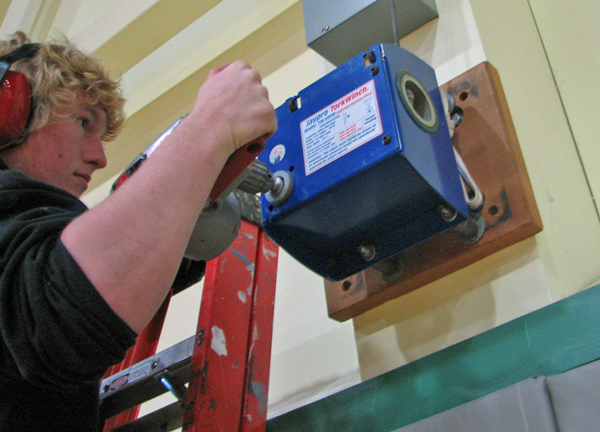
Manufacturing – like everything else – is becoming more computerized, but instead of replacing craftsmanship, digital technology is opening up possibilities for students to create things in ways that simply weren’t practical five or ten years ago.
Three kids at Sitka High School are building a tool – really just a customized piece of metal – to do an unsung, but important, job in the community. And their collaboration points toward a future where we’ll make stuff differently.
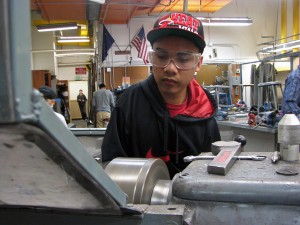
This is a story about hardware. But, on the outside chance you’re not into hardware, there is also some impressive footwork.
KCAW – “So, where are we at?”
Mark – “We’re at an inch and 15-thousanths. I just need to cut 15-thousanths, and we’ll flip it over and do the other side.”
This is Mark Partido, a junior, in the school’s metal shop. The room is dim and cavernous. Kids are welding, and grinding metal. There is a constant racket. In the middle of it all, Partido stands balanced on his right foot, and slides his left foot out of his sneaker, and lifts it to his waist to operate the levers and control handles of a huge metal lathe with his toes .
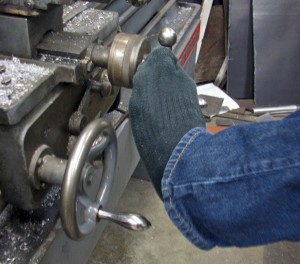
I wasn’t expecting to meet Mark. Someday, someone will do a story just about him and the birth defect, arthrogryposis, that has severely limited his use of his lower arms and hands.
All I can think of is possibly the dumbest question ever asked.
KCAW – “Tell me about running this machine with your feet. Was that a challenge?”
Mark – “A little bit. This is one of my favorite machines to work on. Some of the knobs are a little tough, but you get used to it.”
Mark is shaping a small cylinder of metal into what will eventually become a drill bit – but it’s not for drilling holes. The bit will power a winch to raise and lower the baskets at Sitka’s community gym. The original part has been lost for years.
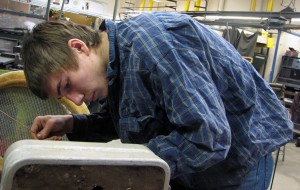
“My name’s Robert Miller. I’m a senior.”
Robert Miller goes by RJ. He made the part Mark is machining, by casting molten aluminum in this kiln in a corner of the shop.
“We’re just trying a bunch of methods, making a bunch of different types of them out of different materials,” Miller said. “I did aluminum casting yesterday. Today I think we’re going to do brass. We’ve done steel, but none of them are finished yet.”
Mark and RJ are experimenting with different metals, but that is as far as the guesswork goes. They also don’t have blueprints. Instead, the pair are meticulously copying a red plastic prototype made across the hall on a $13,000 machine called a 3D printer.
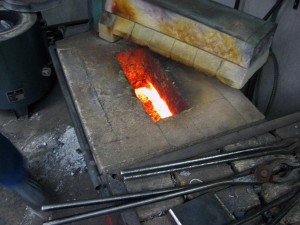
If the metal shop is the brawn – the hands and feet – of this project, the brain is Sitka’s state-of-art Design and Fabrication Lab.
Senior Thor Becker shows me how it works.
“It’s got to be three-dimensional because what it does is take a nozzle that melted plastic comes out of and prints layer-by-layer,” Becker said. “It starts slowly building up, and it has support material that on the bigger one dissolves away, and on the smaller one just rips away.”
The 3D printer is about the size of a mini-fridge. Most of the design work in Sitka’s wood and metal shops starts here, among the rows of computer screens.
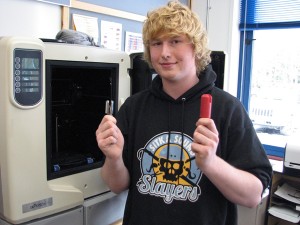
Raising the baskets is important if you want to do anything else in a gym besides play basketball – like volleyball, for example. But for Sitka’s non-profit Hames Center, the $800 replacement part was just too expensive.
Thor offered to help.
“I took a small bit of just regular ceramics clay down there and wedged it into the hole to get an impression of what was in there, what devices needed to be turned,” he said.
He then measured his clay mold, drew the part on the computer, and then clicked on the print button. Thor and RJ and Mark have been fine-tuning it ever since.
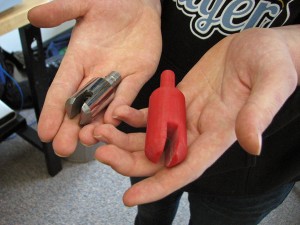
Only one thing left to do.
“Hopefully by the end of the day the metal shop should have the drill bit lathed out and looking nice, and then probably tomorrow I can drive down there and see if it will work,” Thor said.
And it really works.
“My name is Cindy Edwards. I’m the director of the Hames Center, and I’m watching this incredible kid – he’s a master, and he’s done this magical thing – as I watch the basket lifting to the ceiling as he runs that drill. This is amazing! Wow!”
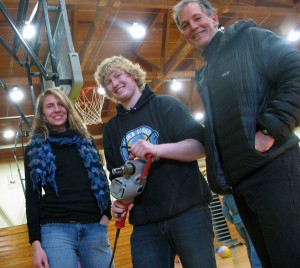
This used to take four people, working in 15 minute shifts, about an hour.
KCAW – “But it’s a gym. It’s not supposed to be easy.”
Edwards – “But this job has been so tedious, that people fall and melt down crying if they have to put the hoop up. And he’s just hitting a button!”
Thor poses for a picture with Edwards, but he’s not ready to officially present her with the bit. He’s going to back to the Fab Lab and print another prototype that he thinks will work even better.
Robert Woolsey is the news director at KCAW in Sitka.




